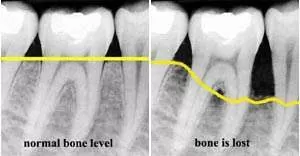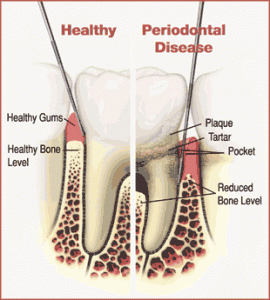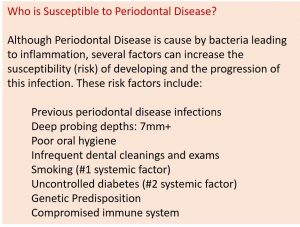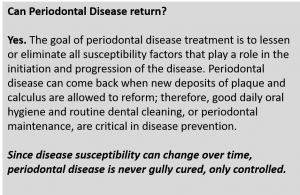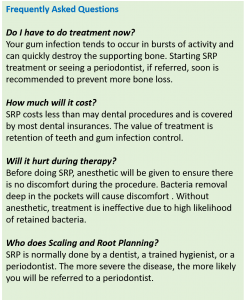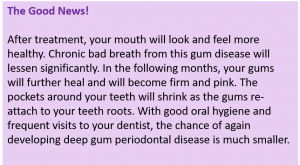What is Periodontal Disease?
Periodontal Disease, a bacterial infection of the gums and bone around your teeth, begins when sticky bacteria, or plaque, and calcified plaque, or tartar, coats your teeth at and below your gum tissues. The bacteria triggers inflammation that leads to bone loss and pocket formation around your teeth.
Unfortunately, you get this infection when your resistance to periodontal bacteria is low and disease susceptibility is high. This infection occurs in bursts of activity and become worse fairly quickly. If periodontal treatment, such as scaling and root planning (SRP), is suggested, it is important to have the treatment done soon to remove the bacteria causing bone and soft tissue damage.
How is Periodontal Disease detected?
At your dental appointment, the hygienist or doctor will look for symptoms of periodontal disease by evaluation; 1) current x-rays for bone loss; 2) inflammation/bleeding; and 3) probing depths around your teeth.
Probing depths of 1-3 mm represents health, while probing depths of 4+ mm often signify periodontal disease present and bone loss. Larger (higher) probing depths mean more bone loss and deeper bacteria deposits.
The severity of the bone loss may necessitate a referral to a periodontist. Early to moderate periodontal disease infections can often be treated by your general dentist office with scaling and root planning (SRP).
What to expect after treatment
You may feel transient gum tenderness and temperatures sensitivity (cold sensitivity is common). These issues should decrease over the first couple of days. Antibiotics; disinfection mouth rinses; desensitizing agents; and mild pain relievers may be needed during healing. You can return home or to work right after your appointment.
With removal of the bacteria, you can expect:
Healthier gum: firm and pink
Tighter teeth (more stable)
Little or no bleeding from gums
Better breath
How is your treatment response evaluated?
Your dentist will usually evaluate your gums 4-6 weeks after treatment by checking the same parameters as at the initial examination: inflammation, bleeding, the presence and amount of plaque and tartar; and your overall oral hygiene. A less than ideal response may require a referral to a periodontist.
Do You Have Other Questions?
We hope this blog has been helpful. Please do not hesitate to call us at 704-933-2115.
